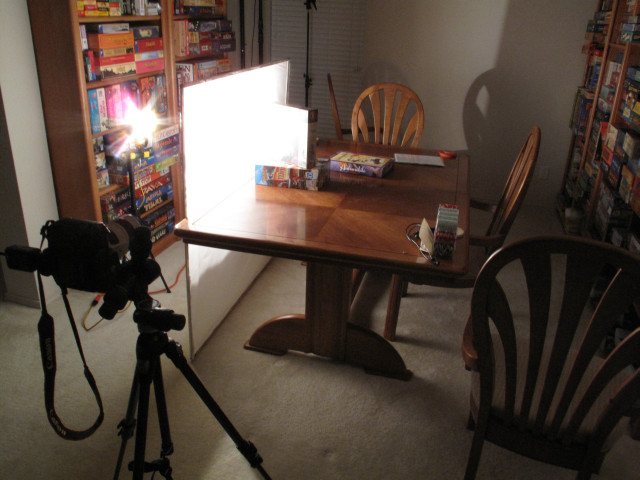I really liked one of the classes at the Austin Photo Expo. Kirk Tuck demonstrated a number of different lighting scenarios by building them on the fly. You could see exactly how the light affects the subject in real time as he moved different modifiers between the light and at different positions. This inspired me to try it at home. I used some advice someone was asking for on BoardGameGeek as an exercise. How do you minimize reflections?
Like other people, I gave some advice at the time. However, it wasn’t really advice that was based on experience. Actually going through the process, changing variables around, and deciding what’s best.
So, I decided to try it out myself. I went to Home Depot and bought a 48″ x 48″ screen frame kit. And I went to Hobby Lobby and bought a roll of 18″ x 50 yards 8lb lightweight tracing paper. It was relatively easy to tape together three lengths of paper and install it into the screen frame.
This was the setup:
I used one 1250 watt halogen work light for the lighting. And, for the worst possible model, I used a shrink-wrap copy of Rocketville. Which I have yet to give to someone I don’t like.
The first image is setup so that the light is directly reflected off of the plastic. What can I say about this except that you should expect it to be denied. And not because it is Rocketville.
The next image has the diffuse screen in between the light and the game. The “point” light source has been transformed into a large and even light source.
In the next image, I rotated the game slightly. However, it was enough to move the direct reflection of the light out of the picture. Well, almost. The edge still has some glare to it. But you can keep rotating the glare away from the camera.
And in the next image, I put the screen back between the light. This time, you can see the glare back into the picture. This is because the light source is much larger so that you are now seeing a direct reflection of the light again.
So, it seems that the best advice for this scenario is to have a small, point light source and move either the light or the subject so that there is no direct reflection from the light to the subject and back to the camera.

